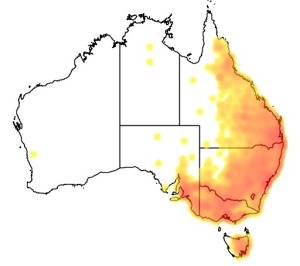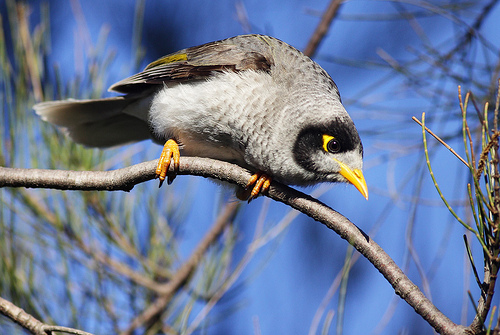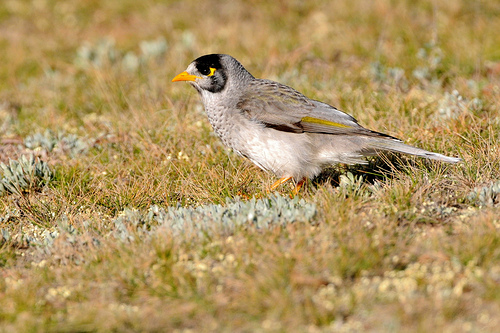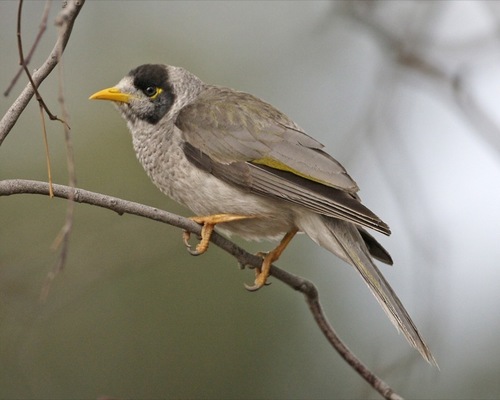Colours
Distinguishing features
Male, female and juvenile birds all have similar plumage: grey on the back and tail and on the breast, and otherwise white underneath, with white scalloping on the nape and hind-neck and on the breast; off-white forehead and lores; a black band over the crown, bright orange-yellow bill and a distinctive patch of yellow skin behind the eye; a prominent white tip to the tail; a narrow olive-yellow panel in the folded wing; and orange-yellow legs and feet.
A juvenile can be distinguished by softer plumage, a brownish tinge to the black on its head and the grey on its back, and a duller, greyish-yellow skin patch behind the eye. (Wikipedia)
Size
- From 24 cm to 28 cm (Length of specimen)
Wingspan
- From 36 cm to 45 cm
Synonyms
Distribution

©Atlas of Living Australia: Australian distribution: Noisy Miner (Manorina (Manorina) melanocephala)
Distribution and habitat preferences
It is endemic to eastern and south-eastern Australia, occupying a broad arc from Far North Queensland where there are scattered populations, to New South Wales where it is widespread and common from the coast to a line from Angledool to Balranald, through Victoria into south-eastern South Australia, and eastern Tasmania. Its range in South Australia has been steadily expanding since it was first recorded near Adelaide in the early 1890s.
It is sedentary over its entire range. The Noisy Miner is territorial, and the territory of a colony is aggressively defended, which has led to a significant reduction in avian diversity in areas occupied by the Noisy Miner, with smaller species excluded.
It primarily inhabits dry, open eucalypt forests without understory shrubs. It is commonly found in open sclerophyll forests, including those on coastal dunes or granite outcrops; forests dominated by spotted gum on mountain ridges and exposed slopes; box and ironbark forests on the foothills of the Great Dividing Range; mixed forests of eucalypts and cypress (Callitris); forests dominated by yapunya, mulga, gidgee, brigalow or emu bush; in stands of belah and scattered clumps of boree; on the edges of woodlands of river red gum including swamp woodlands bordering floodplains, and areas dominated by exotic species such as European ash and willow. It regularly inhabits degraded patches of forest where the understory has been cleared, including recently burned areas, and modified habitats such as lightly-timbered farming and grazing areas, roadside reserves, bushland remnants in towns and cities, and suburban parks and gardens with trees and grass but without dense shrubbery. (Wikipedia)
Audio recordings
Diet
It primarily eats nectar, fruit and insects, and occasionally it feeds on small reptiles or amphibians.
It is both arboreal and terrestrial, feeding in the canopy of trees and on trunks and branches and on the ground. It forages within the colony’s territory throughout the year, usually in groups of five to eight birds although hundreds may gather at a stand of flowering trees such as banksia.
The Noisy Miner collects nectar directly from flowers, hanging upside down or straddling thin branches acrobatically to access the nectar; it takes fruit from trees or fallen on the ground; gleans or hawks for invertebrates; and picks through leaf litter for insects. (Wikipedia)





